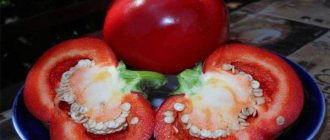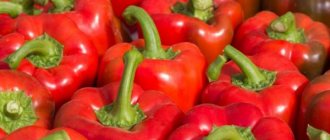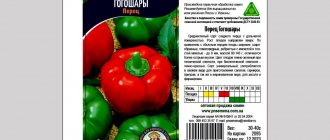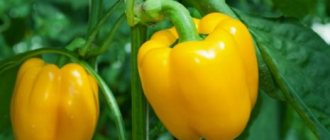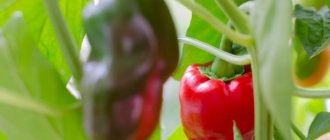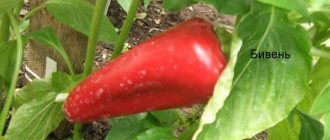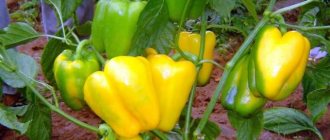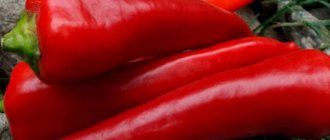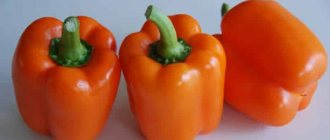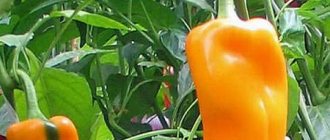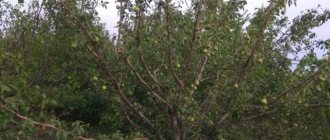Characteristics and description of the variety
The golden calf was bred by breeders from Siberia, therefore it has high immunity to unpredictable climate and common diseases . Peppers are grown in open ground, greenhouses or greenhouses.
The mid-season variety produces a harvest 100-110 days after planting. The bushes are low-growing and compact, the leaves are classic green. The golden calf is planted in seedlings or without seedlings; organic matter or mineral complexes are used as fertilizing. The fruiting period is extended, which allows you to enjoy delicious peppers for as long as possible.
Productivity and fruits
The fruits are large, weighing from 250 to 500 g per one. They have a slightly ribbed glossy surface and a rich yellow-orange color (see photo). There are few seeds, the pulp is very juicy and sweet.
Pepper has a high shelf life and can be stored for a long time. From one bush, summer residents remove from 10 to 14 large and beautiful fruits.
Features of cultivation, planting and care
Sowing seeds for seedlings is carried out 65-70 days before the intended planting of plants in a permanent place. The optimal temperature for seed germination is 26-28°C. When true leaves appear on the plants, they are transplanted into separate cups with a capacity of 0.3-0.5 liters.
Pepper does not like transplanting, so do not be surprised if after you have transplanted the seedlings into separate containers, they stop growing for a while. You can “smooth out” the stressful state a little by spraying the plants with Epin.
Other interesting types of peppers with photos, descriptions and reviews from gardeners in our Pepper Varieties catalog. Enjoy watching.
When to plant pepper seedlings in the ground
After the threat of return frosts has passed, the seedlings can be planted in a permanent location. Some people plant in open ground in May, while others only plant under covering material or under film; it all depends on the climatic conditions of your region.
When planting pepper seedlings in the ground for 1 sq. m area it is recommended to place 4-6 plants, no more. Peppers are planted in the ground without being buried, but in exactly the same way as they grew in cups. Pepper plants, unlike tomatoes, very rarely produce lateral roots, so there is no point in deepening the bush.
Pepper responds well to watering and fertilizing with complex mineral fertilizers. During the summer, 2-3 feedings are usually done.
Preparation for cultivation
To obtain a high-quality harvest, gardeners prepare seeds: they carry out disinfection, germination and hardening. To understand which seeds are of the highest quality, they are tested for germination. Pour the seeds into a jar of water and stir the water with a spoon. Those seeds that sank to the bottom of the jar are planted, and the rest are thrown away.
Disinfection is carried out using aloe juice or hydrogen peroxide, in which the seeds are left for a day. The products destroy dangerous microbes on the surface of seeds and reduce the risk of developing diseases.
Next, they are germinated by placing them in a damp gauze bag. Sprouting helps seeds adapt to external conditions and improve immunity. 1-2 weeks before planting, the seed is hardened by placing it in the freezer for an hour every day. Thanks to hardening, the Golden Calf can easily withstand frost, rain and fog.
Important ! Experienced summer residents advise preparing beds for peppers in the fall. To do this, dig up the soil and fertilize it with peat or humus. With the arrival of spring, the beds are dug up again, straw is laid on them and sprinkled with river sand. Golden Calf pepper is planted in sunny and well-warmed areas.
How to plant seedlings
To ensure a successful harvest, seedlings are prepared. This requires a container and soil. Any clean container is suitable as a container: flower pots, egg nets or plastic boxes. Prepared soil is poured into them and small grooves are made.
The distance between seedlings should be at least 10 cm. Immediately after planting, the seedlings are watered with settled water at room temperature.
Important ! Soil from the garden or ready-made mixtures are used as soil. There is no consensus on which is better. Regardless of the composition and quality, the soil is disinfected with a manganese solution, and all debris (remains of past plants, twigs, larvae) is removed from the soil.
Seedlings are usually placed on a windowsill where there is plenty of sunlight. At first, the container is covered with thin glass or cling film, which is removed after 5-7 days. This makes it easier for plants to adapt. To accelerate growth, stimulants and liquid organic fertilizers are added to seedlings. Fitosporin, bird droppings, and nettle solution are recognized as excellent remedies.
Water the Golden Calf variety regularly, every 3-4 days. For convenient watering, use a pipette, with which water gets directly under the root, and not on the leaves. Fertilize seedlings every 15-20 days. Wood ash, Bordeaux mixture or copper sulfate solution are used as fertilizer. The products not only strengthen the plant, but also serve as the prevention of many diseases.
Important ! After two weeks, gardeners plant (transplant) the seedlings into a larger container. This is due to the fact that the root system is developing and needs more free space. When picking, it is important not to damage the thin and still weak roots of the bell pepper.
Planting peppers in open ground
Plant the Golden Calf pepper on a dry and windless day. Before planting, water the beds generously with warm water to make the soil soft and moist. The sprouts are placed 15-20 cm deep into the ground, the distance between the bushes is at least 30 cm.
Before planting, the shovel and other tools are disinfected with a manganese solution to prevent fungal infections.
Growing technology
The golden calf is grown by seedlings. Seedlings are planted 60 days before they are transplanted to places of permanent growth. The optimal temperature for seed germination is +28 degrees. When the first leaves appear on the seedlings, they are transplanted into separate small containers - cups.
Main stages of the growing process:
- Transplanting young plants to places where they will constantly grow. In open ground conditions, seedlings are planted at the end of frost, when frost will not return completely. In greenhouse and greenhouse conditions, this period falls in the spring: late April - early May. The plant does not like the replanting procedure and may temporarily stop growing.
- Planting is carried out in two rows with a distance between them of about 50 cm. The distance from one plant to another is maintained at 45 cm. There is no need to bury the roots of plants; they rarely produce lateral shoots. The depth of the hole is equal to the depth at which the seedling grew in the cup.
- Preparing selections for future bushes. They grow powerful, but under the weight of a large number of large ripening fruits they can bend to the ground.
- Forming a bush by removing stepsons up to the first fork.
- Thinning the ovaries. To obtain large-sized fruits, no more than two ovaries are left in one bunch.
- Peppers are harvested when they are greenish-yellow to ripe orange in color.
- Before flowering, plants are treated with garlic infusion or a special product called Fitosporin. This will prevent the possibility of them getting sick.
Fresh Golden Calf can be stored in a cool place for up to one month.
Air humidity should not exceed 65%. Bulgarian pepper of this variety, according to gardeners, has shown itself to be an unpretentious vegetable crop with a high level of productivity. Pepper is not difficult to grow and care for; it is enough to follow simple agrotechnical rules and take preventive measures to prevent the development of diseases to which the plant is susceptible.
For more than 10 years, the Golden Calf pepper has been grown by summer residents and gardeners in Russia. In open ground, these are mainly lands located in Siberia or in the European part of Russia (in its central zone). In the Moscow region and Leningrad region, the crop is grown in closed conditions: greenhouses or greenhouses. Pepper remains in demand and popular, along with new varieties and hybrids being offered.
Pepper Golden Miracle - description and characteristics of the variety
Caring for sweet peppers
Caring for peppers does not require special knowledge or skills. This is another plus of the variety. To get a tasty harvest, you need:
- Water the beds every 5-7 days. On average, one bush requires 1-1.5 liters of water. Summer residents recommend using rainwater rather than tap water.
- Weed the beds once a week, remove weeds and loosen the soil. These procedures are necessary to make the soil more airy and nutritious.
- Fertilize the plant once every two weeks. Pepper reacts positively to mineral complexes, for example, the drug “Tsitovit”. It reduces the fall of ovaries, increases productivity, and prevents diseases.
Features of cultivation and possible difficulties
During the growing process, beginning gardeners may encounter a number of problems. Therefore, more experienced gardeners recommend:
- Water the peppers sparingly, without over-moistening the soil. Excess moisture can lead to the appearance of fungi and viruses.
- Loosen the soil to a maximum depth of 10-15 cm so as not to damage the roots.
- Water the beds in the early morning or evening when there is no sun.
- Remove weeds after each watering or rain.
- Spray the bushes with soapy water or Bordeaux mixture 2-3 times per season.
- Form bushes. As soon as 10 leaves form on the stem, cut off the side shoots.
Pepper care after planting
It includes the following steps:
- Loosening the soil - it is better to begin the procedure when the seedlings are well rooted, and this happens no earlier than 14 days after planting. The next loosening of the rows should be done after watering or rain, trying not to touch the bushes, which break very easily.
- Bush formation involves removing excess shoots to increase yield. It begins from the moment the plant reaches a height of 20 cm. The two strongest shoots are left, the rest are pinched off. The remaining shoots begin to branch, and weak shoots in each branch are removed. This must be done with each shoot that bifurcates.
- Stepchildren - stepsons come off below the branching of the main shoots.
- Tying the bushes consists of placing a support near the plant and tying it to it, since the described pepper variety produces a large harvest, and the bush may not withstand the load during the ripening of the fruits.
- Fertilization - carried out several times. The first time the seedlings are fertilized 2 weeks after planting in a permanent place. You can use slurry (1:5) or bird droppings (1:10). You can also dilute 15–20 g of ammonium nitrate, 40–50 g of superphosphate, 15–20 g of potassium chloride in 10 liters of water. Water at the rate of 1 liter of fertilizer per plant. The second time you need to fertilize is when fruiting begins. The third time, fertilizing can be done with organic fertilizers during the abundant development of fruits.
- Regular watering - done with warm water, not abundantly, and as the soil dries out.
Important! To attract pollinating insects to the pepper bed during flowering, you need to treat the bushes with sugar syrup.
Typical diseases and pests
Among the pests, the beds with sweet peppers are attacked by the spider mite, which, thanks to its web, sucks vital substances from the bushes. For prevention, summer residents use soap sprays, and if the bug has already appeared, they use the effective drug “Maxim”. In addition to mites, Colorado potato beetles, aphids, and mole crickets are also found in the garden. A solution of copper sulfate helps fight pests.
It happens that the Golden Calf gets brown spot. It appears due to contaminated soil or improper care. They fight brown spot with the help of the drug “Zaslon”, which is used in strict accordance with the manufacturer’s recommendations and dosages.
Important ! The most common disease is late blight. It is a fungal infection that appears as brown and yellow spots on the leaves. It is very difficult to treat late blight; it is easier to prevent its occurrence with proper care and ash fertilizers.
Advantages and disadvantages of the variety
The main advantages of the variety are its taste and appearance. Gardeners actively use the sweet vegetable in cooking: they prepare soups, summer salads, and cold appetizers. In addition, sweet peppers are indispensable in proper and dietary nutrition; they make tasty and healthy nutritious side dishes. Thanks to its bright and appetizing color, the Golden Calf pepper will decorate any holiday table.
Pepper has high immunity, rarely gets sick, and can easily tolerate a long absence of sun and water. It is grown both in the south of the country and in Siberia.
It shows high and stable yields, is stored for a long time, and can be transported over long distances without problems.
Pepper has no significant disadvantages. Some gardeners don’t like the fact that the bushes need shaping. Otherwise, the Golden Calf has no disadvantages.
Reviews
Mostly there are rave reviews from gardeners who love the Golden Calf pepper and regularly plant it. However, there are also less flattering comments.
Marina, Novosibirsk: “I love large-fruited vegetables, the Golden Calf variety is no exception. I’ve been growing it for three years now and I’m happy with the harvest. Requires minimal maintenance."
Alexey, Saratov: “Of all the varieties, Golden Calf is my favorite. It has delicious pulp, very juicy and tasty. I cook different dishes and eat them fresh. I recommend it to all gardeners."
Irina, Cheboksary: “I planted the seeds in open ground, I thought that the hybrid would take root just like that. However, the sprouts developed slowly, although the soil was fertilized according to all the rules. The harvest turned out to be average, the taste is no different from most other sweet varieties.”
Features of agricultural technology: work schedule and advice from breeders
You can start growing Golden Calf pepper seedlings as early as February. The innate qualities of the crop allow its relatively early planting in a permanent place. After germination, the sprouts will need 60-70 days to become full-fledged bushes. For maximum yield, follow the recommendations for pinching.
Advice. Place on 1 square. m of land for up to 5 varietal plants.
Sowing seeds for seedlings | Planting seedlings in a greenhouse/greenhouse | Planting seedlings in exhaust gas | Stepsoning | Harvesting (in the greenhouse / in the greenhouse) |
| End of February - first half of March | All May | Late May-early June | Remove shoots up to the 1st fork. Leave no more than 1-2 ovaries in each bunch | Mid-July/late July-August |
| *dates are indicated for central Russia | ||||
